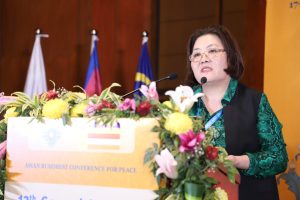Statistics based on historical circumstances
The study of Buddhism in contemporary Mongolia is inextricably linked to the social and historical external conditions of the spread of Buddhism in Mongolia on the one hand, and secularism on the other hand.
According to the results of the first population census conducted in 1918 with the help of Russia, at the beginning of the 20th century, Mongolians were almost all Buddhists. At that time, the population of Mongolia was 542,540, with 21.3% of the total population – equivalent to 105,577 individuals identifying as monks, about 20% of the entire population, or one out of every 5 people were Buddhist monks.
“In 1924, shortly after the passing of Bogd Khan Javzandamba, the head of the sovereign state, the First Constitution of the People’s Republic was adopted. It contained the following article: ‘In order to safeguard and grant full freedom of conscience to every citizen of the country, it is deemed necessary to separate religious affairs from political matters, allowing individuals to freely determine and practice their religious beliefs according to their own will.'”
In Mongolia, where almost everyone was Buddhist, the People’s Democratic Party, which took power after the People’sRevolution in 1921, took many measures to destroy religion under the influence and leadership of the Comintern and the Soviet Union. In the 1930s, about 30,000 monks were persecuted and about 1,000 Buddhist temples were demolished.
The intense repression that reached its peak during 1937-39, and the events that brought societal upheavals as a result of it forced Mongolians to renounce their religion and beliefs without their consent and to hide their devotion. Until the 90s of the 20th Century, Mongolia was a member of the communist system and implemented the theory and ideology of communism, so it forced the public to become atheist/secular.
The restrictions related to religion and beliefs in our history in the 20th century were characterized by the direct leadership and influence of the ruling Mongolian People’s Revolutionary Party within the country and the Comintern and the Communist Party of the Soviet Union from abroad.
In the 2010 population census, Mongolia conducted its first survey on the religiosity of the population. According to the census, 61.4% of the total population identifies as religious, with 53% being Buddhists. Furthermore, 86.2% of all individuals who follow a religious belief adhere to Buddhism.
Thus, Mongolians were publicly Buddhists at the beginning of the 20th century, and after 70 years they became atheists. In the mid-1980s, the percentage of religious people increased from 19.6% to 72.8% by 1994, However, in 2010, it decreased to 61.4 %.
According to the new Constitution adopted in 1992, the citizens of Mongolia have the freedom of conscience, it allows free practice of religion.
Academic research
On November 19, 1921, “The Institute of Manuscripts” (Sudar Bichgiin Khureelen) was established as the first scientific academic institution in Mongolia. One of the main areas of research of the institute was the study of Buddhism, and in the late 1920s, the catalog of Mongolian Danjuur (Bstan-‘gyur) was cross-referenced with the source texts and subsequently released as the “Complete Catalogue of Danjuur” or “Tib. bsDan bcos ‘gyur ro cog gi dgar chag.” This publication, presented in the form of scripture, contributes to the development of Buddhist religious literature and spans 227 pages in Tibetan and Mongolian characters.
From this point of view, our Academy of Sciences has been working on registering recording, cataloging, and exploring the contents of Buddhist sources since its inception. Buddhist grammar or Buddhist linguistics and its branches have made a special contribution to the development of Mongolian literature. Mongolians who studied the traditional science of healing have developed medical sciences.
In 1970, the Department of Buddhist Studies was established in the Institute of History of the Mongolian Academy of Sciences, later it was named “Buddhist Studies Sector” and transferred to the Institute of Philosophy, Sociology and Law in 1973. Since that time, the treatises of main schools of Buddhist philosophy, its prominent Buddhist thinkers, and sources have been studied in the sector. The Sector of Buddhist Studieshas studied the history of Mongolian philosophical thought in connection with Buddhist teachings and published joint works such as “Some Issues in the History of Mongolian Philosophy” (UB, 1990) and “Overview of the History of Buddhist Philosophy” (UB, 1991)
Analysing the works published by researchers in the field of Buddhist studies, the research has been conducted on various aspects, including the social and political views of Mongolians, the history of Mongolian Buddhist philosophy, Buddhist logic, Yogachara (Vijnanavada) philosophy, Madhyamaka philosophy, Prajnaparamita (the perfection of wisdom), astrology, and the writings of some prominent Buddhist masters.
One of the significant characteristics of Mongolian Buddhist masters is their proficiency in the Tibetan language, leading to the creation of textbooks in Tibetan language and Tibetan-Mongolian dictionaries.
During the period when communist ideology dominated our society and teaching Buddhist doctrine in civil schools and institutions was prohibited, the history of Buddhist philosophy was imparted under the title ‘History of Mongolian Philosophy’ in the curriculum of the Philosophy Department at the National University of Mongolia. At this time in history, it is interesting that ABCP was established at the initiative of our Buddhist researcher and Gandan Tegchenling Monastery.
In 1998, the Buddhist philosophy program was first introduced in our department. Today, we are conducting research on Buddhist studies and, offer undergraduate and graduate courses in religious studies, and advanced Buddhist philosophy courses in the department.
Our teachers and faculty members have been engaging in research, translation, and publication of commentaries on Buddhist philosophy written by Mongolian Buddhist masters. They have also delved into the history of Mongolian Buddhism, biographies of Khutagt and Khuvilgaan, Buddhist logic, Yogachara (Vijnanavada) philosophy, Madhyamaka philosophy, Prajnaparamita (the perfection of wisdom), Abhidharma, and Buddhist ethics, among other topics.
In conclusion, I believe it is important to undertake the following initiatives for the further development of Buddhist research in Mongolia.
Firstly, implement a translation project for the works of Mongolian Buddhist masters.
Secondly, establishing exchange programs for faculty members, researchers, and students from Buddhist Universities, along with organizing summer school programs on Buddhist studies.
Thirdly, fostering the sharing and exchange of data, texts, and resource materials related to Buddhist studies. Encouraging young scholars to collaborate on joint articles for publication in professional journals and inviting scholars to join the editorial boards of Buddhist journals.
Lastly, the comparative study of Buddhist and Western philosophies is becoming increasingly significant. This area holds the potential to develop into one of the key areas of Buddhist research in Mongolia. New research topics, such as the religious issues faced by Mongolians during historical transitions from secularism, questions of religious freedom, and the formation of religious institutions in this process, are emerging.
By Professor M. Otgonbayar and S.Demberel (Ph.D. candidate),
Head of Department of Philosophy and Religious Studies,
National University of Mongolia.


